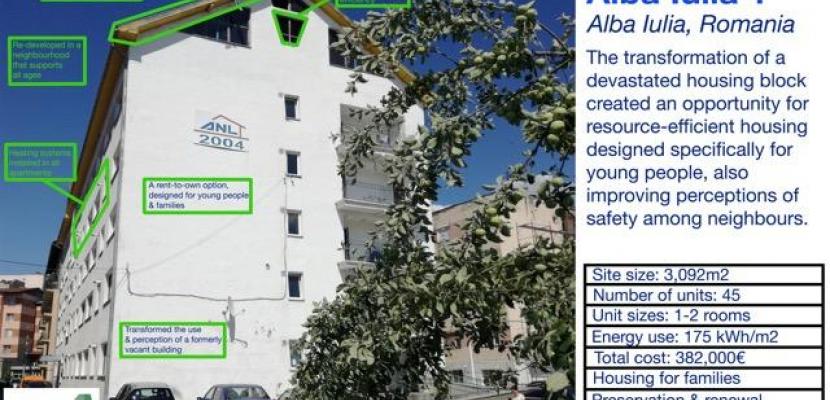Image

Green retrofit of collective flats in Alba Iulia
Published on 20 April 2018

Romania
Centru
This is the good practice's implementation level. It can be national, regional or local.
About this good practice
Alba Iulia Municipality redeveloped a dilapidated collective flat building into social housing, using funds provided by the National Agency for Housing. The preservation and reuse of the old building reduced potential waste as well as the need for additional building materials had it been torn down and reconstructed. Building energy consumption was improved to 175 kWh/m2 per year.
Owned by the State, the building was built in the 1970s to provide housing for the workers within the city’s factories. There were 79 rooms with one collective bathroom/kitchen at each floor. Due to improper administration the building was abandoned and it massively deteriorated. After the reconversion, the building now has 36 single room apartments, 9 double room apartments, which are specifically available for low-income families.
The project included different operations, including building new walls to reconfigure the room structure, installing an elevator, connecting all apartments to the gas network, and installing gas cooking machines, and installing insulation in the walls and the roof. Thermal windows and a heating system was also installed in all the apartments.
Thus, the practice contains some aspects of energy efficiency measures in a building retrofit, but the major benefits have been improving the living standard for vulnerable residents (specifically young people), as well as the positive impacts on the surrounding community.
Owned by the State, the building was built in the 1970s to provide housing for the workers within the city’s factories. There were 79 rooms with one collective bathroom/kitchen at each floor. Due to improper administration the building was abandoned and it massively deteriorated. After the reconversion, the building now has 36 single room apartments, 9 double room apartments, which are specifically available for low-income families.
The project included different operations, including building new walls to reconfigure the room structure, installing an elevator, connecting all apartments to the gas network, and installing gas cooking machines, and installing insulation in the walls and the roof. Thermal windows and a heating system was also installed in all the apartments.
Thus, the practice contains some aspects of energy efficiency measures in a building retrofit, but the major benefits have been improving the living standard for vulnerable residents (specifically young people), as well as the positive impacts on the surrounding community.
Expert opinion
The practice provides a concrete example of how existing buildings can be given a new lease of life, in an energy efficient manner. This has benefits in terms of resource efficiency (compared to demolition and rebuilding), and maintains the historical integrity of the city. The practice turns a social problem (disused building) into a social benefit (quality housing for young people and families).
Works at
Interreg Europe Policy Learning Platform
Resources needed
The project was financed from:
- The National Agency for Housing funding – 1,041,576.57 lei (261,702.65 EUR as at March 2004)
-The Municipality Budget – 478,794.4 lei (120,300.10 EUR as at March 2004)
- The National Agency for Housing funding – 1,041,576.57 lei (261,702.65 EUR as at March 2004)
-The Municipality Budget – 478,794.4 lei (120,300.10 EUR as at March 2004)
Evidence of success
Turning a dilapidated building into social housing that is now occupied by young people and families, is clear evidence of the success of the project. The ability of tenants to buy their homes at reasonable prices after proving the financial capacity also looks promising; however more time is necessary to confirm the effectiveness of this approach. The significant improvement in energy performance and to the built environment also underlines the success of this project.
Potential for learning or transfer
The project has great potential for scaling to other cities or regions facing similar issues related to lack of social housing and affordable dwelling availability for your young people. The retrofit of an existing building for young people represents a good example of reduced waste of new materials while solving a major social problem in an economical way. In practice, this can be difficult to implement, as developers often favour new construction over retrofits, particularly in areas with a reputation for buildings in poor condition. However, the experience of positive impacts on the surrounding community, as well as the social and economic benefits of offering well-situated and connected housing, should inspire other municipalities to consider their existing building stock before defaulting to the norm of new construction.
Further information
Website
Good practice owner
You can contact the good practice owner below for more detailed information.
Organisation
Alba Iulia Municipality

Romania
Centru
Contact
Financial Manager
